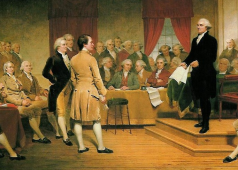Website Guide
“Putting Government In Its Place” spells out a radical new model for what American government should do.
This guide summarizes the contents--and the flow--of the following sections.
Rethinking Government
The first section, Rethinking Government, explains the need to think anew American government--to set aside the debate about the size of government, and concentrate on the more important question of what exactly we want government to do. It shows how government simultaneously looms large, yet hides in plain sight, thus enveloping our thinking in a kind of fog that often obscures the essential questions we must answer.
The section then outlines both the major successes and worst failures of American government. It suggests that the best way out of our foggy thinking is to understand government as a solid stage--a strong foundation--upon which private actors (individuals, families, organizations, and communities) play out their decisions.
The section concludes by arguing that, since the New Deal of the 1930s and its 80-year aftermath created the current structure of our government, we must revisit this New Deal writ large. We need to understand the New Deal's underpinnings, honor its achievements, and recognize its flaws, in order to create a new and better design that puts American government in its proper place. Turn to ->
A New Design
The second section, A New Design, delves into how we should think about re-designing American government. It spells out ten design principles (cutting across all policies and programs) that should guide the restructuring of government at every level. It concludes by showing how those design principles--as carried out by the detailed policy proposals that follow on creating economic security, providing equal opportunity, and making the market effective--all combine to enhance Americans' most cherished value: freedom. Turn to ->
Economic Security
The third section, Economic Security, describes in detail the policy changes needed to greatly strengthen the nation's system of economic security and equal opportunity. It also presents a new mechanism for delivering the major programs that provide economic security and equal opportunity. The proposed changes will help to greatly reduce racial disparities and injustice, as well as help to help reverse the nation's rising level of income and wealth inequality. Enacting the proposed economic security system will in turn justify the elimination of "poverty-requiring" welfare programs. Turn to ->
An Effective Market
The fourth section, An Effective Market, presents the new policy direction that is required to greatly improve the efficiency and productivity of America's market. It presents the rationale for ending "externalization" of costs, and for ending subsidies for specific types of investment and consumption, as essential to strengthening the American market and the nation's economic competitiveness. Turn to ->
Getting There
The fifth and final section, Getting There, makes the case that, however impossible the proposed re-design of American government may seem, the history of our country consists of a series of popular movements that achieved the impossible. We were never going to create a new nation, abolish slavery, give equal rights to women, pass a Social Security Act, let farm workers bargain, or elect a black man as our President...until we did.
The section then explains in detail that the proposed new design rests on budgetary calculations that are reasonable, and will not result in major changes in government spending or revenue. Taxes will go down, fees will rise, and the deficit shrink somewhat. Responsibilities will shift among the three major levels of government--local, state, and federal. But the overall fiscal picture alters little.
The section concludes by identifying practical ways to phase in the new design of American government. A step-by-step approach that takes advantages of "windows" of opportunity makes perfect sense.
The main challenge is not to give up, to be patient and creative, and above all to stay focused.
In building the new design, the most important strategy is to keep an eye on the ball and make it home. Turn to ->





